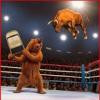Scanning the hourly, daily, and weekly charts, one has to applaud the incredible resilience and strength of this market, as evidenced again this past week by record equity fund inflows. Only a major domestic political or geopolitical or an external factor or RAPID BOND YIELD increases or FED certainty of 4 or more rate hikes in 2018, will result in any major sustained decline. Unless that happens, But The Dip will continue. Yeah, bulls and others will be nervous but the market can continue to climb this proverbial wall of worry month after month...
-------
.Why the Bulls Should Be Nervous
March 17, 2018
Tariffs? Chaos in the administration? So what? And payoffs to a porn star? Puh-leeze!
That seems to be the stock market’s response to the flood of news to which it’s subject on a daily basis. It has developed its own antidotes to the flotsam flowing out of the nation’s capital, which can be best described by their acronyms: FOMO (fear of missing out) and BTFD (buy the dip, with a certain modifier).
Following the stock market’s brief but violent drop in February, investors came roaring back with record purchases of equity funds in the most recent week ended on Wednesday. According to EPFR data cited by Bank of America Merrill Lynch, some $38.3 billion was poured into mutual funds, including the exchange-traded variety. That period included the 400-plus-point pop in the Dow Jones Industrial Average after positive news from the jobs market the Friday before last.
The exodus from Donald Trump’s administration continues with surprisingly little lasting effect on the financial markets. The firing-by-tweet of former Secretary of State Rex Tillerson caused but a momentary ripple. Ditto the win in a special congressional election by a Democrat in a district long held by a Republican—one that Trump won by some 20 percentage points in 2016. At week’s end, reports swirled of further departures, any of which might be out of date by the time this is published.
The resignation of Gary Cohn as director of the National Economic Council did cause some perturbation in stock prices, but far less than predicted. That Cohn’s successor was Lawrence Kudlow, a member of the cable commentariat, brought the assurance that the new NEC head would at least do no harm to asset values. In a bit of histrionics, The Wall Street Journal editorial page shouted to dump stocks if Peter Navarro’s, Trump’s arch-protectionist adviser, got the job.
Kudlow, an ardent advocate of free trade, nevertheless professed to have come around to Trump’s view on tariffs—that they could be a useful cudgel to get other countries, notably China, to lower trade barriers. Kudlow’s intellectual flexibility is not new: he was converted to a Reagan Republican from a member of the ultraleft Students for a Democratic Society in the 1960s. In his new role, he may be best viewed as the spokesman for the Trump bull market and someone who will argue against policies that could hurt stocks.
As for the market, there is confidence bordering on complacency that the “carve-outs” Trump made for Canada and Mexico for the steel and aluminum tariffs mean there won’t be a trade war. Reportedly, the president also is asking for stiff tariffs against China, which could be used as a weapon against that country’s trade surplus. Who knows what to expect from Trump, who expressed a willingness to sit down with North Korea’s Kim Jung-un, whom he previously called “Little Rocket Man”?
Regardless of politics or geopolitics, the renewed enthusiasm on the part of investors implied by the latest fund flows should give bulls pause more than the unending flow of news on the tube or your phone. Just before the market suffered its sinking spell in early February, there was a similar surge of buying of mutual funds and ETFs, totaling some $100 billion in January, as Gluskin Sheff’s David Rosenberg relates. Moreover, foreign investors poured $33.5 billion into U.S. equities in January after buying an even larger, $37.1 billion in December, according to Treasury data.
That follows almost perfectly the script of Bob Farrell, the legendary market analyst, with whom Rosenberg worked at Merrill Lynch, and whose wisdom has long been featured in this space: “The public buys the most at the top and the least at the bottom.”
The insouciance with which fund buyers commit to the equity market ignores the risks posed by possible policy mishaps. Those can be viewed through the lens of the stock price of Boeing (ticker: BA). The aircraft manufacturer could face both higher materials costs from the steel and aluminum tariffs and possible trade restrictions as reprisals against U.S. exports. At midweek, the shares were down 13% from their recent peak, set on Feb. 28. For the week, they ended down a steep 7% and were the biggest drag on the Dow, which ended 1.54% lower.
Amid the talk of tariffs, staff turnover, and scandals, what gets lost is the arcane, but simple, math that ought to trouble the markets. Regardless of one’s opinion of the fiscal measures to lower taxes and increase spending, they will widen the trade deficit, which is Trump’s putative target. Higher budget deficits draw on the nation’s savings; the difference has to be borrowed from abroad. The capital inflows mean an increased trade deficit, all else being equal. This isn’t theory; it’s double-entry accounting.
Attempting to reconcile this contradiction may be the real source of pressure on the markets in the months to come, especially if it means higher interest rates. Kudlow has suggested that the Federal Reserve should let the economy “rip,” which would mean a decline in what he calls “King Dollar.” How this plays out may be more interesting than any scandals.
Perhaps the least surprising headline to come out of Washington next week will be that the Federal Reserve has raised its key interest rates by another 25 basis points, or one-quarter of a percentage point.
There’s a 100% chance the policy-setting Federal Open Market Committee will increase its federal-funds rate target range that much—to at least 1.5%-1.75%—according to Bloomberg’s tally of fed-funds futures. (There’s actually an 18% probability of a 50-basis-point hike, which would send shock waves throughout the financial world and thus is highly unlikely.)
The real (not fake) news will be in the FOMC’s guidance for further rate boosts over the rest of the year. In other words, watch what they say, not what they do, the inverse of the famous John Mitchell dictum.
For the first time, Jerome Powell will be doing the talking, both chairing the Fed meeting and conducting the press conference at its conclusion on Wednesday afternoon. Based on his congressional testimony last month, Powell should be able to explain the Fed’s outlook for the economy and rates without much equivocation. In other words, the opposite of Alan Greenspan, who once remarked, “If I’ve made myself too clear, you must have misunderstood me.”
The key is likely to be the Fed policy makers’ take on the economy as a whole and the labor market in particular. Recall that the markets were roiled after the January jobs data were released in early February but were encouraged by February’s employment report, which came out on the Friday before last.
Based on the last set of economic projections and dot plots of year-end fed-funds rate projections issued at the December FOMC meeting, the consensus of the panel calls for three rate hikes in 2018. That had been predicated on the committee’s estimate of inflation approaching, but not exceeding, the central bank’s 2% inflation target.
A jump in average hourly earnings in the January jobs numbers, to an originally reported 2.9% year-over-year clip, set off inflation and interest-rate worries that spread to arcane inverse-volatility investments and, in turn, battered stocks. The slightly more subdued 2.6% year-over-year average hourly earnings increase in February, despite a much-bigger-than-expected rise of 313,000 in nonfarm payrolls, ignited a huge rally on March 9.
That relatively restrained pace of pay increases with a jobless rate of 4.1%, at or below what economists deem full employment, seemed to reflect a surge of workforce entrants, who apparently had been sitting on the sidelines, including 806,000 in February alone. It appeared the labor force participation rose in response to improved labor market conditions. In other words, stronger labor demand was eliciting more labor supply.
Not so fast, argues Charles Lieberman, chief investment officer of Advisors Capital Management after stints as chief economist at a number of big New York money-center banks. Much of the increase in the workforce appears to have resulted from Puerto Ricans emigrating to the U.S. mainland from the hurricane-devastated island.
Lieberman cites some persuasive data in the last two jobs reports. Among them, the total U.S. labor force grew by 1,324,000 in the past two months. And the Latino labor force rose by 523,000, accounting for 39.5% of the total national gain. But Latinos account for just 16.5% of the U.S. population, so these percentages “are completely out of line.”
“So, it may be more appropriate to conclude that many Puerto Ricans fled to the continental U.S. because of unlivable conditions at home and readily found jobs here, since the country is desperate for workers. The idea that so many people out of the labor market came back and found jobs so quickly in such a short period of time may be wishful thinking. The surge in hiring will boost [gross domestic product] growth temporarily, for as long as the influx continues. But it would also distort assorted key labor market measures, such as average earnings or the unemployment rate,” he writes.
For now, to paraphrase Lin-Manuel Miranda, the composer of Hamilton, these “immigrants,” they get the job done. If they return to Puerto Rico, the mainland’s labor shortage could worsen, Lieberman adds. In which case, the rise in the labor supply will be short term, and the shortages discussed in last week’s cover story (“The Great Labor Crunch,” March 10) will remain.
And if the upward pressure on wages resumes and feeds into prices, the markets’ expectations of three rate hikes in 2018 may be too conservative. To be sure, emerging weakness in retail sales and housing will have to be balanced against that. In any case, news about the FOMC should provide a welcome departure from coverage of the other Washington chaos.
Email: randall.forsyth@barrons.com
https://www.barrons....vous-1521247195














